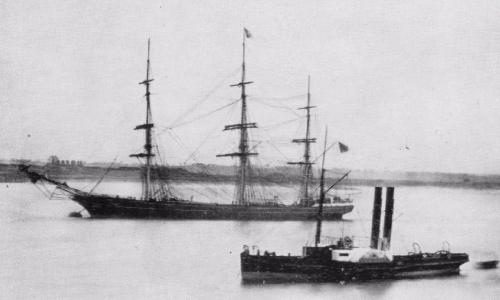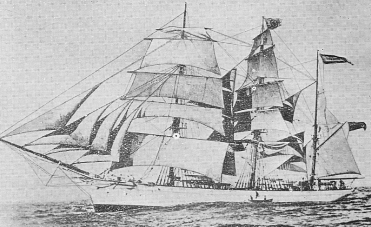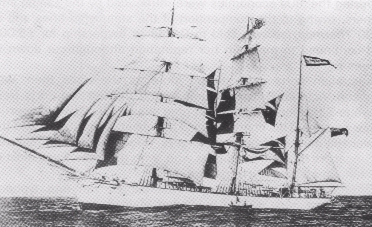Q: "How can I find out more?"
It is easy to build a kit out of the box ... it is fun, and every modeller starts like this. It is a hobby :)
Or, You begin to doupt when You realize that some plans and depictions cannot be correct compared to the real sailing ship.
Today I know why: the companies that produce the kits simplified the plans and thus made the model easier to build, in order not to "overdemand" the average hobby modeller.
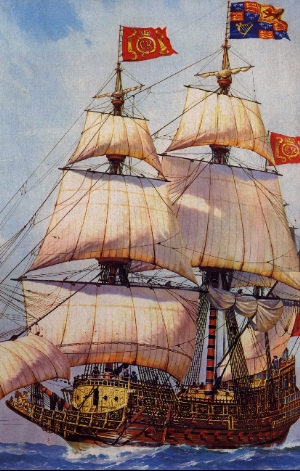
|
Most model kits have a "box art", a superb painting of the ship as the front cover of the box, to attract people to buy the kit. These box arts
are eye catchers indeed ... but
maritime artists also make "mistakes" that only very few will ever notice. Especially photorealistic paintings showing a dramatic scene make us believe that any detail
was exactly as depicted in the image - it is regarded as a photo, because it looks like a photo.
For example, this box art of the Airfix model kit Royal Sovereign (Classic Ship Series, now sold out long ago).
I *love* this picture! It is so inspiring ... so what is wrong with it? Is there
anything "wrong" here at all? - Yes, just a small detail:
The Fore Topgallant sail shows 4 buntlines; it should have only one, if any, like this:
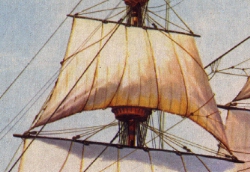
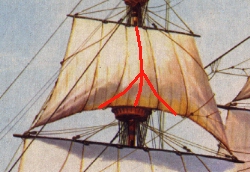
The artists (I would like to know his name!) applied modern patterns for buntlines to an ancient ship - that is the "mistake".
How do we know that? There is an old engraving preserved of the HMS Royal Sovereign (1637), which is today
the "blue print" for all model kits of this ship. That engraving shows in fact no buntlines for the topgallants, but 2 leechlines (correct in the box art)
and 2 slab lines(!) behind the sail
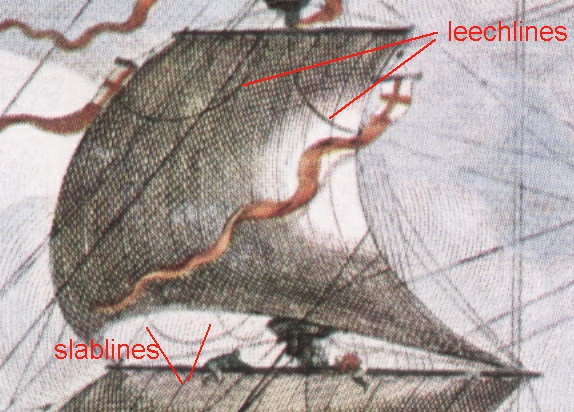
Now we could discuss what image is more "reliable" ... after all it is ranking two images, made by artists who knew both quite a lot of rigging, because their
depictions are both very detailed.
I made my first Airfix model of the
HMS Royal Sovereign (1637) back in 1980. This was also the initial trigger for my interest in details like this.
Yet, the kit was quite easy and it was not necessary to "fix" things like this (unless You start building "on scratch"). Today I build my second Airfix
kit of the same ship, but with more emphasis to historic accuracy.
|
In my "private career" as a modeller, I noticed so many "strange things", and so, 100 questions came up to my mind ...
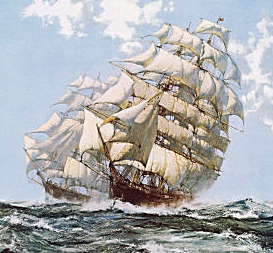
|
Another example: the marvellous paintings of clipper ships show them with all available canvas set. Such a picture is very impressing, indeed ...
... but while most people keep being impressed, I see details, e.g. the Stunsails (pronounciation of Studding Sails), extra sails apperently set to both sides of all yards!
They are supposed to be set
in light weather conditions only - and here we see them all set in a gale like this? Sorry, but something must be wrong here ... as a hobby painter, I made a similar painting
as a student, and I made the same "error" by simply not knowing about studding sails, that is: how weak they are.
This truely magnificant artwork was painted by Montague Dawson in the 1950s (and reproduced over and over since then), when all clippers except the Cutty Sark had disappeared long ago.
Stunsails came out of use between 1870 and 1900, just when steam shipping "phased out" all sailing ships.
The last sailing ships setting Stunsails
were training ships (e.g the Swedish Jarramas and Najaden).
The knowledge about their usage is almost completely lost: there is very few information at all about this detail, and only a handful
of original photos, as photography became usuable not before 1860.
|
When I became interested in these questions some 30 years ago, I knew nobody who could answer to those questions. So what could I do to find out more? I was still a kid, and the internet was yet completely beyond any imagination, back in 1975.
Even most seamen of today no longer have a clue about sail rigging, or its history - modern ships no longer have sails.
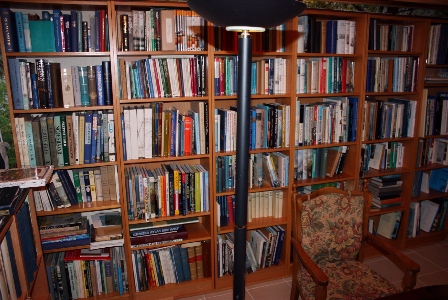
|
Eventually I turned to books as my first sources.
I started collecting books for my private library ... and I am still continuing.
Back to Stunsails again:
Dana´s book "Two Years before The Mast" was referred to by C. Nepean Longridge (in his "bible" about the Cutty Sark!)
as an evidence that studding sails in fact had been set even on races around Cape Horn - and when I wrote the text for this page, I have to admit that
I did miss that, but it is described nearly at the end of Danas book; Dr. Ottfried Thümmel now sent me a mail,
and he indeed found the chapter I was obviously missing,
as I previously doupted it: but it was in chapter XXXIII (33),
where Dana describes how a fore top stunsail (which side is not mentioned, but obviously only ONE side) has been added to the rigg,
despite there was a gale, and the all hands on deck first thought that the captain was M-A-D ... but they carried out the orders.
It was a hard work of one hour to set it at all in the strong wind - with ALL hands for ONE sail! -,
and to secure it. The top stunsail boom was of special spruce wood
that bowed under the enormous pressure without carrying away...the ship was then almost "flying" over the waves, giving the helmsmen a hard time!
Then, they also added the lower fore stunsail, too (!), but that blew away short time after that. And for two days, the top stunsail was still up
with the ordinary courses and reefed topsails, adding speed up to 11 knots for the ship, until the wind lessened eventually.
It was also described that this new stunsail had a unique feature: a reef! It sounded like they had only this one for one side, as they speak of only one,
which could be used on any side as needed.
OK, this IS an evidence, thank You to correct me, Mr. Thümmel! I want to encourage anybody, if You have some comments, pls send them to me!
BUT: I still think it was not common to use the stunsails in such a daring way. Some ships may have done so, but then only the clipper ships,
but doing it like Montagues pictures suggests, it was right at the edge to hazard the entire rigging, and to get totally dismasted eventually.
|
Q: "How do we know? What sources do we have?"
or: The Myth of "Original" ...
We have in fact very little evidence. We have to rely on ancient sources as books and depictions. The rigging of old ships, with the exception of only a handful of wrecks found,
is lost entirely. Secondary literature, which is most of our material available today, is only resampling and reconstructing these ancient descriptions.
Contemporary and Modern Models
Well, building a model after a (better) model is of course an "option", but those models usuable for this are very rare, indeed, and are all in a museum,
or hidden in a private collection. Those models are definitely not for lending, like books.
So the only thing one can do in a museum is: making pictures: photos or self made drawings. IF making photos is allowed ...
Ancient Depictions and Illustrations
Artworks: Drawings, Paintings, Lithographies and Prints
The quality of these images are depending on the maritime knowledge of the artist. The images vary from "very naive" and unclear to photorealistic.
Before the era of the Renaissance, "realistic" depictions are non-existent to our modern sense. Most details interesting to a modeller are missing.
But between 1500 and 1900, realistic maritime artworks have been made in abundance; many captains were proud to have a portrait of their ships in the cabine.
Most of them are preserved in the museums or private collections.
But, a photorealistic picture can be misleading quite easily, just because it is so realistic. And because it is a standing picture and not a movie - it freezes a short moment
and shows it in eternity - , the image
makes us believe that the rigging depicted had been applied all the life span of the ship, over decades - this is not true! A steady painting of a ship
completely hides the flexibility that a rigging always had. The backstays wave in the winds and smack against anything in their ways - unless they are secured,
by means missing in the pictures.
Top mast spars were often under repair (fatigue fractures) and change, or they were taken down, because a lofty rigging
is a safety hazard in a storm: it is useless because the royals and topgallants cannot be set, and even without sails, the storm can blow the top rigging away.
Thus, the entire rigging was overhauled maybe several times a year! There is no "original" condition, the rigging changed all the time over the lifespan of the ship.
On the other hand, these images are our only depictions available before photography was invented and became usuable after 1870.
Modern artworks, made after photography was used, can be even more misleading, to a "naive" observer. Those artists often consulted photography
as sources for their paintings, to make them more realistic:
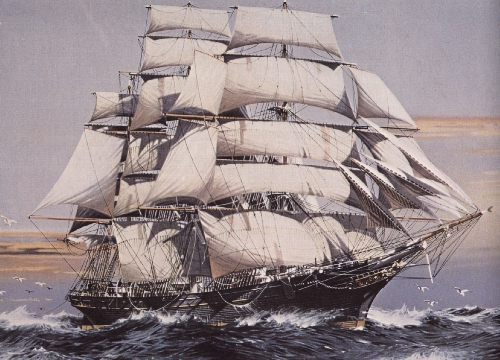
Obviously, they were quite successful, like Spurling in 1924, but their images are just as questionable
as the ancient artworks, when You go into details: here, the stunsail tacks go forward on deck. In this wind, the strain on the booms from abaft is so strong
that it is much more likely to let the tacks lead abaft and haul them taut, to secure the stunsails in their position ...just my 2 cents :)
Please do not think I am too picky about this - a captain of these days would have felt being insulted to see his ship portrayed almost perfectly - "but, hey, there are only 6 main shrouds,
we have 7, can´t You SEE?"
Photographies
It has become so extremely easy to makes photos in our time that it becomes ever more inimaginable how difficult it was in the early days ...
The quality of all photographies was depending on these limiting facts:
I do not know a single photo showing a sailing clipper ship with stunsails. I only know many non-photographic images that show them, but many are questionable.
Virtually all early photos show sailing ships with sails furled or drying in a harbour. And of those rare ones showing sails, only a small part show enough details.
Later photos were better, but at as time went by, the old ships were lost.
We today, in 2009, are so used to look at 1000 *excellent* images (or more) each day. In 1909, the sheer existing of a single photo reproduced in a book was a sensation!
Those old images are all utterly rare, especially to our overfed eyes. But, when You find an image usuable for rigging research, it tells You more than an entire book:
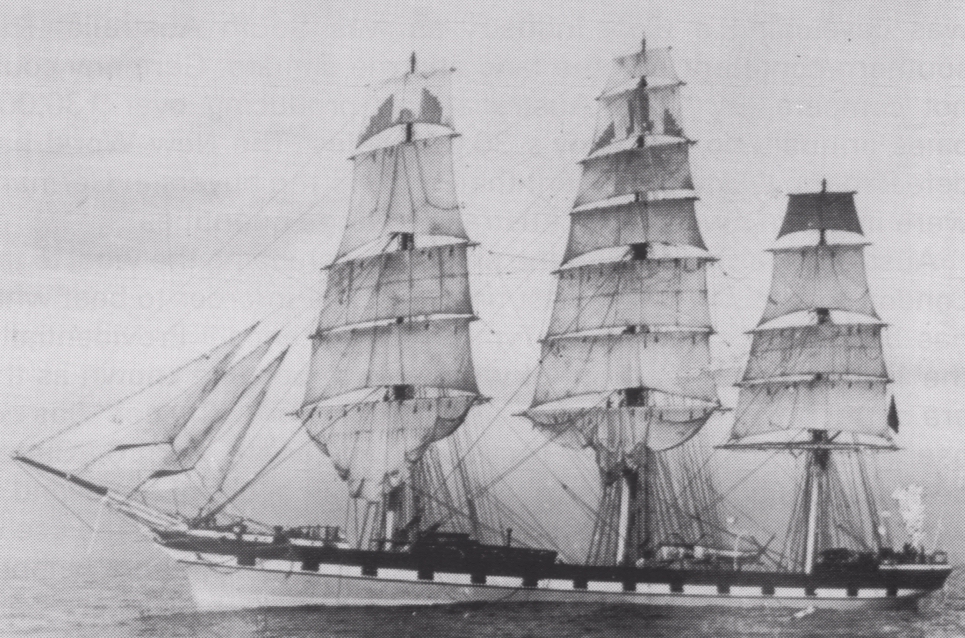
The wool clipper Argonaut. 90% of the running rigging can be identified and thus reconstructed, using this single image!
(found in Hume/Armstrong: The Cutty Sark and Thermopylae Era of Sail)
Contemporary Sources and Secondary Books
There are of course books that contain a lot of images mentioned above, but they also contain many information that was not possible to depict. For instance,
the orders given to set or furl sails, tables with all proportions and instructions how to build a ship and how to make sails.
The problem is: how reliable are these soucres?
What is "reliable"? - or: Why do I doubt?
The deeper You go back into history, the less original documents are preserved. Those we have do not tell us very much, and what they tell us is not a strong evidence.
From a forensic point of view, it is just a bunch of contradictory testimonies.
Example: a document of the 16th century mentioning the famous Mayflower described the ship simply as having
"160 tons" - and that´s it!!! We know NOTHING more about this ship than that.
Another contemporary document says that she had "130 tons", and nothing more (at least about the ship).
Well, these tons may refer to different cargos, and we also can doupt how it was measured ... or estimated :)
For the contemporary people, all that was of no interest,
the ship was nothing more than a vehicle to sail to a destination, and to carry some amount of cargo and passengers.
What formed our modern cliché about this ship is entirely a result of reconstruction, from quite contradictory "facts".
Then, 95% of all the literature was written in the last 50 years, it is
secondary literature,
which reconstructs many things that never even had been mentioned
in any original sources, which contain only a few details, if any. A few books from the 18th century, like the famous "Steels Elements", do contain many details indeed,
but they do not document a special ship "as built", but a number of ways how ships should have been built in those days - these are patterns.
It can only be assumed (or doubted as well) how far these rules were followed.
I have more on
books here
in my library :)
Personal Researches

It is all but reconstruction ... I spent many evenings over my books.
Be careful what examples or books You rely on, even the very best of them can be "wrong",
that is: it can be prooved that a special detail never had functioned the way it is shown.
Just one example: a rope can never lead through the capstan bars. Why not?
The rope and the capstan make each other malfunctioning. But this is what You see at THE most famous
Admiralty Model, of the HMS Prince
in the Science Museum in London!
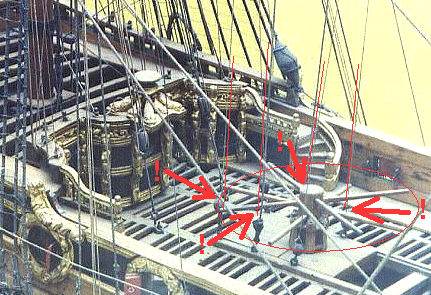
How come? The model was built in the 17th century, but the rigging was added in the 19th century.
Since it is an Admiralty model having no planks, all details upon the planks
added afterwards must be wrong without planks which are still "missing".
At this point, You are on Your very own, when no other sources are available.
The ropes I am talking about here are actually the braces of the Fore yards coming down from the stays.
They led most probably to the forecastle rails.
This is what research is about: look and think!
Here are some 100 books dedicated to ship modelling:
| TITLE | AUTHOR | PUBLISHER | YEAR | PAGES |
AIRFIX magazine annual for modellers
(English) |
Ellis, Chris |
PSL |
1971 |
96 |
American Ship Models and how to build them
(English) |
Grimwood,V.R. |
Bonanza Books |
1952 |
188 |
Building & Detailing Scale Model Ships
FineScale Modeler Magazine (English) |
Ashey, Mike |
Airlife Publishing |
1996 |
110 |
Building a Clipper Ship
(English) |
Coleman, H.S. |
Modelcraft Ltd. |
(1960) |
70 |
Building Model Ships from Scratch
(English) |
Porter, Kent |
TAB Books |
1977 |
377 |
Building Plank-on-Frame Ship Models
(English) |
McCarthy, Ron |
Conway |
2004 |
192 |
Captain Cook´s Endeavour
Anatomy of the Ship (English) |
Marquardt, Karl-Heinz |
Conway |
1995 |
136 |
Chinesische Flussdschunken
Modellbaureihe DK (German) |
Wieg, P. + Freyer, J. |
DK |
1988 |
80 |
Church Ships
(English) |
Harvey, Basil |
The Canterbury Press |
1994 |
78 |
Collection of Ship Models
(English) |
Henry Huddleston Rogers |
United States Naval Academy Museum |
1971 |
138 |
CSS Alabama - Anatomy of a Confederate Raider
(English) |
Bowcock, Andrew |
Chatham Publishing |
2002 |
192 |
Cutty Sark
Classic Ships (airfix) (English) |
Hackney, Noel C.L. |
PSL |
1974 |
96 |
Das Grosse Buch der Schiffsmodelle - international
(German) |
Williams, Guy R. |
Umschau Verlag |
1973 |
256 |
Das Hanseschiff im ausgehenden 15. Jahrhundert
Modellbaureihe DK (German) |
Winter, Heinrich |
VEB Hinstorff |
1968 |
68 |
Das historische Schiffs als Modell 2
Das historische Schiffs als Modell (German) |
Albert, Alfred |
Koehler |
1985 |
116 |
Das historische Schiffs als Modell 3
Das historische Schiffs als Modell (German) |
Albert, Alfred |
Koehler |
1988 |
112 |
Das historische Schiffs als Modell 4
Das historische Schiffs als Modell (German) |
Albert, Alfred |
Koehler |
1990 |
78 |
Das historische Schiffs als Modell 5 - exzellente Miniaturmodelle
Das historische Schiffs als Modell (German) |
Albert, Alfred |
Koehler |
1991 |
88 |
Das Modellbaubuch - Tips und Anregungen
(German) |
|
Revell |
1976 |
128 |
Das PELLER-Modell von 1603
Modellbaureihe DK (German) |
Jaeger, Werner |
DK |
1973 |
128 |
Der holländische Zweidecker von 1660 / 1670
Modellbaureihe DK (German) |
Winter, Heinrich |
DK |
1967 |
54 |
Der Schiffsmodellbau nach historischen Vorbildern
(German) |
Lusci, Vincenzo |
Alexander Engel KG |
(1960) |
180 |
Die Brigg
Modellbaureihe DK (German) |
Dåbritz/Quinger |
DK |
1983 |
64 |
Die Fregatten Peter und Paul und Heiliger Paul
Modellbaureihe DK (German) |
Wagner, Wolf-Dietrich |
DK |
1966 |
44 |
Die Kolumbusschiffe von 1492
Modellbaureihe DK (German) |
Winter, Heinrich |
VEB Hinstorff |
1968 |
68 |
Die Mayflower
Modellbaureihe DK (German) |
Hackney, Noel C.L. |
DK |
1978 |
80 |
Die Schebecke und andere Schiffstypen des Mittelmeeres
Modellbaureihe DK (German) |
Mondfeld, Wolfram zu |
VEB Hinstorff |
1974 |
64 |
Die Schiffe des Christoforo Colombo
(German) |
Mondfeld, Wolfram zu |
Koehler |
1991 |
216 |
Die schönsten Schiffsmodelle der Welt
Das historische Schiffs als Modell (German) |
Albert, Alfred |
Koehler |
1984 |
112 |
Down-Easter - Building a Model of the BENJAMIN F.PACKARD
(English) |
Bragdon, R.W. |
Falmouth Publishing House |
1954 |
110 |
Enzyklopädie des Schiffsmodellbaus
(German) |
Curti, Orazio |
DK |
1992 |
520 |
Gedeckte Korvette Elisabeth
Modellbaureihe DK (German) |
Greven, Hermann-Joachim |
VEB Hinstorff |
1991 |
120 |
Historische Modellschiffe
(German) |
Mondfeld, Wolfram zu |
Heyne |
1980 |
310 |
Historische Schiffsmodelle
(German) |
Mondfeld, Wolfram zu |
Orbis verlag |
1995 |
380 |
Historischer Schiffsmodellbau - Schritt für Schritt gezeigt
(German) |
Reed, Philip |
Verlag für Technik und Handwerk |
2003 |
136 |
HMS Beagle - Survey Ship extraordinary
Anatomy of the Ship (English) |
Marquardt, Karl-Heinz |
Conway |
1997 |
128 |
How to make Clipper Ship Models
(English) |
Hobbs, Edward W. |
Brown, Son & Ferguson |
1960 |
216 |
How to make Old Time Ship Models
(English) |
Hobbs, Edward W. |
Brown, Son & Ferguson |
1962 |
208 |
How to make Ship Block Models
(English) |
Davis, Charles G. |
Edward W. Sweetman Co, NY |
1970 |
150 |
Hur man bygger fartygsmodeller
(Swedish) |
Ellerström+Ohrelius |
P A Norstedt & Söners Förlag |
1972 |
104 |
Klipperschiffe des 19.Jahrhunderts
Modellbaureihe DK (German) |
Hölzel, Wolfgang |
DK |
1976 |
82 |
Knochenschiffe - Die Prisoner-of-War Modelle 1775-1814
(German) |
Mondfeld, Wolfram zu |
Koehler |
1989 |
238 |
Last Days of Mast and Sail
(English) |
Moore, Alan |
Oxford University Press |
1925 |
260 |
Le Vaisseau de 74 canons - Tome 1
(French) |
Boudriot, Jean |
Éditions des 4 Segnieurs |
1974 |
166 |
Le Vaisseau de 74 canons - Tome 2
(French) |
Boudriot, Jean |
Éditions des 4 Segnieurs |
1974 |
212 |
Le Vaisseau de 74 canons - Tome 3
(French) |
Boudriot, Jean |
Éditions des 4 Segnieurs |
1975 |
280 |
Le Vaisseau de 74 canons - Tome 4
(French) |
Boudriot, Jean |
Éditions des 4 Segnieurs |
1977 |
382 |
Mayflower
Classic Ships (airfix) (English) |
Hackney, Noel C.L. |
PSL |
1970 |
80 |
Model Sailing Boats
Cassells Model Series (English) |
Hobbs, Edward W. |
Cassell |
1923/1941 |
312 |
Model Shipwright - An Anthology 1972-1997
(English) |
Bowen, John |
Conway |
1997 |
192 |
model shipwright INDEX 1972-1997
(English) |
|
model shipwright (Conway) |
1997 |
32 |
model shipwright vol I (numbers 1-4)
(English) |
|
model shipwright (Conway) |
1978 |
416 |
model shipwright vol IV (numbers 13-16)
(English) |
|
model shipwright (Conway) |
1977 |
416 |
Modelismo naval
(Spanish) |
Guillén, Julio O. |
Doncel |
1963 |
186 |
Modellbau von Schiffen des 16. und 17. Jahrhunderts
Modellbaureihe DK (German) |
Hoeckel, Rolf |
DK |
1966 |
128 |
Modellbouw van schepen 16de en 17de eeuw
Modellbaureihe DK (Dutch) |
Hoeckel, Rolf |
P.N. van Kampen |
1979 |
128 |
Modeller af vore gamle sejlskibe - vejledning for modelbyggere
(Denish) |
Kisling, H.M. |
Borgens Forlag |
1972 |
168 |
Modelling Ships in Bottles
(English) |
Needham, Jack |
PSL |
1972 |
64 |
Modelling Thames Sailing Barges
(English) |
Freeston+Kent |
model shipwright (Conway) |
1975+ |
96 |
Modelling the Archibald Russell
(English) |
Bowness, Edward |
Marshall |
1947 |
84 |
Modelling the Brig-of-War Irene
(English) |
Petrejus, E.W. |
N.V.Uitgeversmaatschappij De Esch |
1970 |
286 |
Modelling the Cutty Sark
(English) |
Bowness, Edward |
MAP |
1976 |
60 |
Modelling the Golden Hinde
(English) |
|
model shipwright (Conway) |
1973 |
96 |
Norman Lindsay´s Ship Models
(English) |
|
Angus & Robertson |
1966 |
100 |
Old Ships Figure-Heads and Sterns
(English) |
Laughton, L.C.Carr |
Dover |
1925/2001 |
282 |
Om fartygsmodeller
Statens Sjöshistoriska Museum Meddelanden I (Swedish) |
Albe, Gerhard |
Statens sjöhistoriska museum |
1947 |
95 |
Plank-on-Frame Models and Scale Masting and Rigging Vol I+II
(English) |
Underhill, Harold A. |
Brown, Son & Ferguson |
1958/1974 |
160+160 |
Prins Willem
Modellbaureihe DK (German) |
Ketting, Herman |
DK |
1981 |
144 |
Prisoner-of-War Ship Models
(English) |
Freeston, Ewart C. |
Nautical Publishing |
1973 |
174 |
Rigging Period Ship Models
(German) |
Petersson, Lennarth |
Catham Publishing, London |
2000 |
120 |
Risse von Schiffen des 16. und 17. Jahrhunderts
Modellbaureihe DK (German) |
Hoeckel + Jorberg + Loef + Szymanski + Winter |
VEB Hinstorff |
1970 |
100 |
Rundhölzer, Tauwerk und Segel
(German) |
Schrage, Klaus |
Koehler |
1989 |
188 |
Sail Training and Cadet Ships
(English) |
Underhill, Harold A. |
Brown, Son & Ferguson |
1956 |
374 |
Sailing Ship Models
(English) |
Nance, R.Morton |
Halton & Company |
1949 |
82 |
Sailing Ship Rigs & Rigging
(English) |
Underhill, Harold A. |
Brown, Son & Ferguson |
1938/1969 |
128 |
Sailing Ships - Their History and Development - Part I
(English) |
|
Science Museum, London |
1932/1947 |
115 |
Sailing Ships - Their History and Development - Part II
(English) |
|
Science Museum, London |
1932/1947 |
120 |
Sailing Ships of War 1400-1860 ---
(English) |
Howard, Frank |
Conway |
1979 |
254 |
Scale Model Sailing Ships
(English) |
Bowen, John |
Conway |
1977 |
192 |
Scale Model Warships
(English) |
Bowen, John |
Conway |
1978 |
192 |
Schiffe aus Knochen und Elfenbein
(German) |
|
Altonaer Museum in Hamburg |
1976 |
|
Schiffe unterm Roten Adler
Modellbaureihe DK (German) |
Schmidt, Günther |
DK |
1986 |
84 |
Schiffsmodelle
(German) |
Hansen, Hans-Jürgen |
Stalling |
(1980) |
166 |
Schiffsmodelle
(German) |
Mondfeld, Wolfram zu |
Mosaik Verlag |
1984 |
240 |
Schlachtschiff Tirpitz
Vom Original zum Modell (German) |
Koop, G. + Schmolke, K-P |
Bernard & Graefe Verlag |
1990 |
56 |
Schoner in Nord und Süd
Modellbaureihe DK (German) |
Marquardt, Karl-Heinz |
DK |
1990 |
296 |
Schwere Fregatte Wappen von Hamburg - Leichte Fregatte Berlin
Modellbaureihe DK (German) |
Winter, Heinrich |
VEB Hinstorff |
1961 |
100 |
Seventeenth Century Rigging
(English) |
Anderson, R.C. |
Marshall |
1955 |
146 |
Ship Model Building
(English) |
Johnson, Gene |
CMP |
1943/1961 |
300 |
Ship Model Making - Vol I
(English) |
McCann, E. Armitage |
The Norman W Henley Publishing Co |
1926 |
130 |
Ship Model Making - Vol II - Clipper Ship
(English) |
McCann, E. Armitage |
The Norman W Henley Publishing Co |
1926 |
150 |
Ship Model Making - Vol III - USS Constitution
(English) |
McCann, E. Armitage |
The Norman W Henley Publishing Co |
1926 |
206 |
Ship Modeller´s Shop Notes
(English) |
Edson, Merritt |
Nautical Research Guild |
1979 |
216 |
Ship modelling hints & tips
(English) |
Craine, J.H. |
Conway |
1973 |
118 |
Ship Models - How to Build Them
(English) |
Davis, Charles G. |
Dover |
1925/1986 |
140 |
Ship Models Illustrated
(English) |
Harman, F.Ward |
Marine Model Company |
1961 |
128 |
Shipbuilding in Miniature
(English) |
MacNarry, Donald |
Percival Marshall |
1955 |
160 |
Ships and Ship Models Vol 1 (1931 - 1932)
(English) |
|
Percival Marshall |
1977 |
384 |
Ships and Ship Models Vol V (1935 - 1936)
(English) |
|
Percival Marshall |
1935 |
390 |
Skepp Fartyg och Båtar - Verktyg och metoder för modellbygge
(Swedish) |
Ellerström+Ohrelius |
Norstedts |
1971 |
148 |
Skeppet i Flaskan
() |
Landström, Björn |
|
|
|
Sovereign of The Seas - How to make a model of the American Clipper Ship
(English) |
McCann, E. Armitage |
Edward W. Sweetman Co, NY |
1967 |
150 |
The 100-gun ship Victory
Anatomy of the Ship (English) |
McKay, John |
Conway |
2004 |
120 |
The 24-gun Frigate Pandora
Anatomy of the Ship (English) |
McKay, J. + Coleman, R. |
Conway |
1992 |
128 |
The 32-gun Frigate Essex
Anatomy of the Ship (English) |
Takakjian, Portia |
Conway |
1990 |
128 |
The 44-gun Frigate USS Constitution
Anatomy of the Ship (English) |
Marquardt, Karl-Heinz |
Conway |
2005 |
128 |
The 74-gun ship Bellona
Anatomy of the Ship (English) |
Lavery, Brian |
Conway |
1985 |
120 |
The Armed Transport Bounty
Anatomy of the Ship (English) |
McKay, John |
Conway |
1989 |
120 |
The Art of Rigging
(English) |
Biddlecombe, G + Pentecost,E.H. |
Edward W. Sweetman Co, NY |
1848/1969 |
156 |
The Battleship Fuso
Anatomy of the Ship (English) |
|
Conway |
1998 |
256 |
The Battleship Yamato
Anatomy of the Ship (English) |
|
Conway |
1988 |
192 |
The Bomb Vessel Granado 1742
Anatomy of the Ship (English) |
Goodwin, Peter |
Conway |
1989 |
128 |
The Built-Up Ship Model
(English) |
Davis, Charles G. |
Edward W. Sweetman Co, NY |
1933/1966 |
210 |
The Four-Masted Barque Lawhill
Anatomy of the Ship (English) |
Edwards + Anderson + Cookson |
Conway |
1996 |
128 |
The Grabtree Collection of Miniature Ships
(English) |
Crabtree, August F. |
The Mariners Museum, VA |
1969 |
50+ |
The Model Ship Builders´ Manual of Fittings and Guns
(English) |
Isard, A.P. |
Faber |
1929 |
328 |
The Schooner Bertha L Jones
Anatomy of the Ship (English) |
Greenhill, B. + Manning, S. |
Conway |
1995 |
128 |
The Ship Model Builder Assistent
(English) |
Davis, Charles G. |
Dover |
1926/1988 |
275 |
The Ships of Christopher Columbus - Santa Maria, Nina, Pinta
Anatomy of the Ship (English) |
Pastor, Xavier |
Conway |
1992 |
120 |
The World of Model Ships and Boats
(English) |
Williams, Guy R. |
Deutsch, André + Rainbird |
1971 |
256 |
Unter Segeln - Vom Einbaum zum Hightech-Segler
(German) |
Veres + Woodman |
DK |
1999 |
352 |
Vane Steering Gears
(English) |
Wilcock, A. |
MAP |
(1975) |
24 |
Von der Fregatte zum Vollschiff
Modellbaureihe DK (German) |
Dåbritz, R. + Quinger, W. |
DK |
1987 |
136 |
Wappen von Hamburg I
Modellbaureihe DK (German) |
Quinger, Wolfgang |
DK |
1980 |
80 |
Wappen von Hamburg III - ein schwimmender Barockpalast
Hamburg Portrait (German) |
|
Museum für Hamburgische Geschichte |
1977 |
12 |
Warships of the Royal Navy - First Series: Sail (Kingsize!!!)
(English) |
Gardner, John |
Hugh Evelyn |
1968 |
64 |
Waterline Ship Models
(English) |
Brown, John |
Conway |
1972 |
114 |
Wikingerschiffe
Modellbaureihe DK (German) |
von Fircks, Jochen |
VEB Hinstorff |
1979 |
80 |
Wiking-Modelle
(German) |
Schönfeldt, Peter |
Koehler |
1998 |
152 |
Windjammer Modelling
(English) |
Monk, Clive |
Faber |
1954 |
128 |
Workshop Hints & Tips - A Model Engineer Handbook
(English) |
Geometer |
MAP |
1969 |
60 |
Zeesboote
Modellbaureihe DK (German) |
Winkler, Hermann |
VEB Hinstorff |
1986 |
160 |
|








